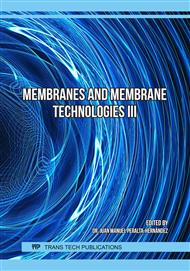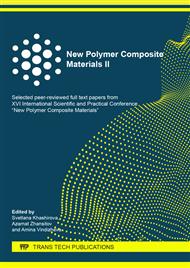[1]
N. Peng, N. Widjojo, P. Sukitpaneenit, M.M. Teoh, G.G. Lipscomb, T.S. Chung, J.-Y. Lai, Evolution of polymeric hollow fibers as sustainable technologies: past, present, and future, Prog. Polym. Sci. 37 (2012) 1401-1424.
DOI: 10.1016/j.progpolymsci.2012.01.001
Google Scholar
[2]
I. Borisov, V. Vasilevsky, D. Matveev, A. Ovcharova, A. Volkov V. Volkov, Effect of Temperature Exposition of Casting Solution on Properties of Polysulfone Hollow Fiber Membranes, Fibers. 7 (2019) 110.
DOI: 10.3390/fib7120110
Google Scholar
[3]
C.Y. Feng, K.C. Khulbe, T. Matsuura, A.F. Ismail, Recent progresses in polymeric hollow fiber membrane preparation, characterization and applications, Sep. Purif. Technol. 111 (2013) 43-71.
DOI: 10.1016/j.seppur.2013.03.017
Google Scholar
[4]
A. Ismail, W. Lorna, Suppression of plasticization in polysulfone membranes for gas separations by heat-treatment technique, Sep. Purif. Technol. 30 (2003) 37-46.
DOI: 10.1016/s1383-5866(02)00097-7
Google Scholar
[5]
A.K. Hołda, I.F. Vankelecom, Integrally skinned PSf-based SRNF-membranes prepared via phase inversion—Part A: Influence of high molecular weight additives. J. Membr. Sci. 450 (2014) 512–521.
DOI: 10.1016/j.memsci.2013.08.050
Google Scholar
[6]
Y. Liu, G.H. Koops, H. Strathmann, Characterization of morphology controlledpolyethersulfone hollow fiber membranes by the addition of polyethyleneglycol to the dope and bore liquid solution, J. Membr. Science. 223 (2003) 187-199.
DOI: 10.1016/s0376-7388(03)00322-3
Google Scholar
[7]
H. Ohya, S. Shiki, H. Kawakami, Fabrication study of polysulfone hollow-fiber microfiltration membranes: optimal dope viscosity for nucleation and growth, J. Membr. Science. 326 (2009) 293-302.
DOI: 10.1016/j.memsci.2008.10.001
Google Scholar
[8]
A.V. Bildyukevich, T.V. Plisko, A.S. Liubimova, V.V. Volkov, V.V. Usosky, Hydrophilization of polysulfone hollow fiber membranes via addition of polyvinylpyrrolidone to the bore fluid, J. Membr. Science. 524 (2017) 537-549.
DOI: 10.1016/j.memsci.2016.11.042
Google Scholar
[9]
I. Borisov, A. Ovcharova, D. Bakhtin, S. Bazhenov, A. Volkov, R. Ibragimov, R. Gallyamov, G. Bondarenko, R. Mozhchil, A. Bildyukevich, V. Volkov, Development of Polysulfone Hollow Fiber Porous Supports for High Flux Composite Membranes: Air Plasma and Piranha Etching, Fibers. 5 (2017) 6.
DOI: 10.3390/fib5010006
Google Scholar
[10]
A. Mansourizadeh, A.F. Ismail, M.A. Aroon, Effect of Different Additives on the Properties and Performance of Porous Polysulfone Hollow Fiber Membranes for CO2 Absorption, in: A.F. Ismail, T. Matsuura (Eds.), Sustainable Membrane Technology for Energy, Water and Environment, John Wiley & Sons Inc., New Jersey, № 16, 2009, pp.191-201.
DOI: 10.1002/9781118190180.ch16
Google Scholar
[11]
L.B. Zhao, Z.L. Xu, M. Liu, Y.M. Wei, Preparation and characterization of PSf hollow fiber membrane from PSf-HBPE-PEG400-NMP dope solution, J. Membr. Science. 454 (2014) 184-192.
DOI: 10.1016/j.memsci.2013.11.057
Google Scholar
[12]
D.W. Reynolds, M. Galvani, S.R. Hicks, B.J. Joshi, S.A. Kennedy-Gabb, M.H. Kleinman, P.Z. Parmar, The use of N-methylpyrrolidone as a cosolvent and oxidant in pharmaceutical stress testing, J. Pharm. Sci. 101 (2012) 761-776.
DOI: 10.1002/jps.22793
Google Scholar
[13]
A.V. Bildyukevich, V.V. Usosky, Prevention of the capillary contraction of polysulfone based hollow fiber membranes. Pet. Chem. 54 (2014) 652–658.
DOI: 10.1134/s0965544114080027
Google Scholar



